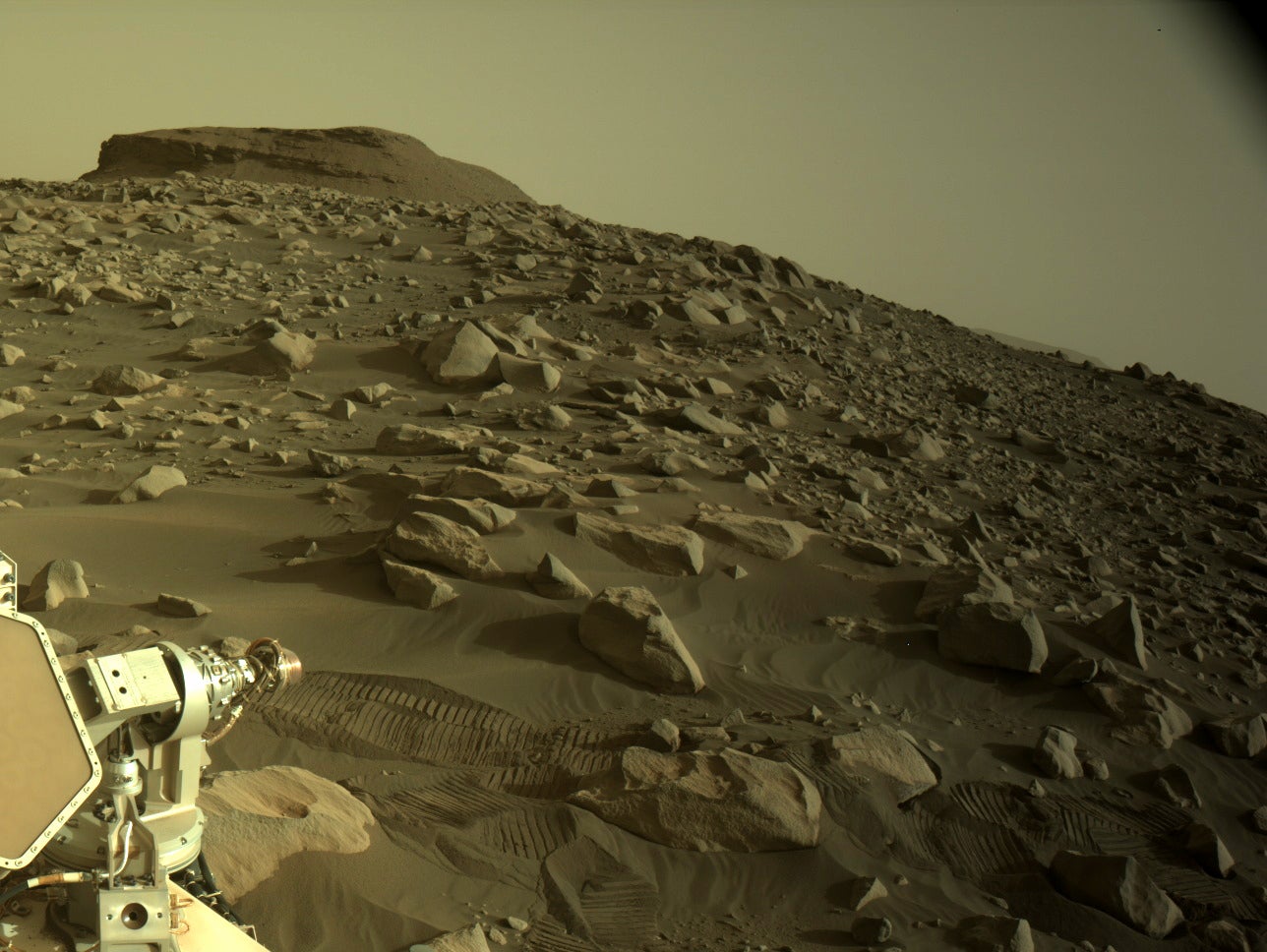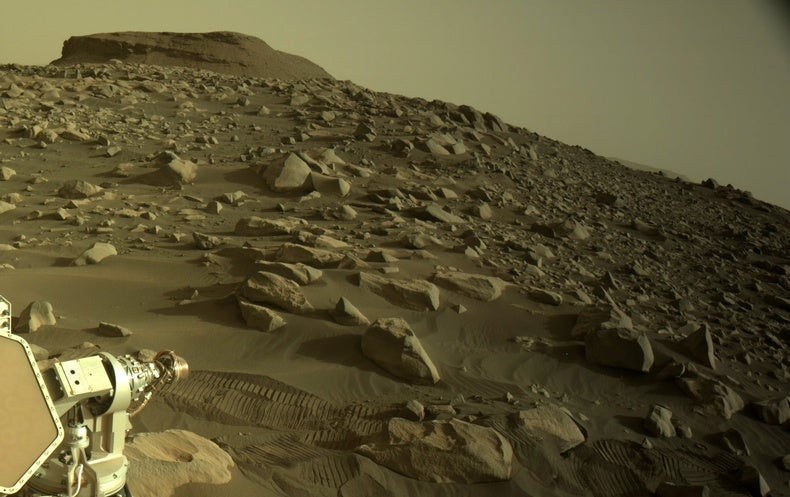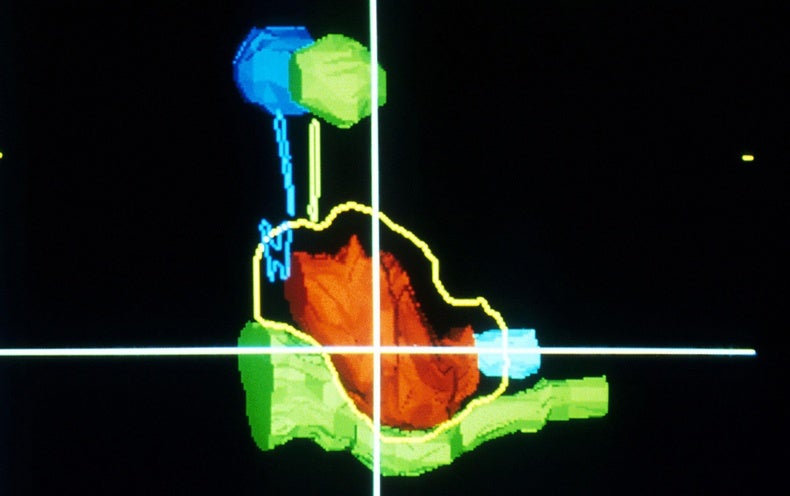
More than 15 months after landing in Jezero Crater on Mars, NASA’s Perseverance rover has finally begun its hunt for ancient life in earnest.
On 28 May, Perseverance ground a 5-centimetre-wide circular patch into a rock at the base of what was once a river delta in the crater. This delta formed billions of years ago, when a long-vanished river deposited layers of sediment into Jezero, and it is the main reason that NASA sent the rover there. On Earth, river sediment is usually teeming with life.
Images of the freshly ground spot show small sediment grains, which scientists are hoping will contain chemical or other traces of life. Poet William Blake’s “‘To see a world in a grain of sand’ comes to mind,” wrote Sanjeev Gupta, a planetary geologist at Imperial College London, on Twitter.
The rover will spend the next few months exploring the Jezero delta, while mission scientists decide where they want to drill and extract rock samples. NASA and the European Space Agency (ESA) plan to retrieve those samples and fly them back to Earth for study, no earlier than 2033, in the first-ever sample return from Mars.
‘Going to the buffet’
Perseverance landed in February 2021, several kilometres from the delta’s edge. It spent many of its early months exploring the crater floor — which unexpectedly is made of igneous rocks, a type that forms as molten materials cool. That was a scientific jackpot because scientists can date igneous rocks on the basis of the radioactive decay of their chemical elements. But many researchers have been keen for Perseverance to get to the delta, whose fine-grained sediments have the best chance of harbouring evidence of Martian life.
The rover finally arrived at the delta’s base in April. It soon spotted grey, thinly layered rocks called mudstones, which could have formed from sediments deposited by a slow river or lake. It also found sandstones with coarse grains, which might have formed in a fast-flowing river. These kinds of rock are excellent targets for studying a variety of Martian environments where life could have thrived, Katie Stack Morgan, Perseverance’s deputy project scientist at the Jet Propulsion Laboratory (JPL) in Pasadena, California, said on 17 May during the online portion of the 2022 Astrobiology Science Conference.
Mission engineers then drove Perseverance away from this region, named Enchanted Lake, and towards another area known as Hawksbill Gap, where it is currently working. The freshly abraded patch was made in a sandstone in one of the lowest rock layers in the delta, which means it is one of the oldest rocks formed by Jezero’s ancient river and thus an excellent place to hunt for signs of ancient life.
The delta rises about 40 metres above the crater floor. Rover drivers plan to send Perseverance up the front of the delta and then back down again, assessing where and how to take samples. “It’s like going to the buffet before you fill your plate,” says Jennifer Trosper, the mission’s project manager at JPL. On the way up, it will scout the rocks, including abrading more patches to see rock interiors. On the way down, it will drill and collect samples of the most intriguing ones.
Like a child assembling a set of gemstones for their prized collection, mission scientists are deliberating over which rocks the rover should sample to amass the most geologically diverse cache. Perseverance carries 43 tubes for samples, each a little thicker than a pencil. NASA and ESA are planning to bring around 30 filled tubes back to Earth.
Mission scientists are already considering where to set down the first set of samples for a future spacecraft to retrieve. Once the rover makes its way back down, it might put some tubes at the delta’s base, in a large flat region between Enchanted Lake and Hawksbill Gap. “There is a very strong possibility we may put down the first cache” when the rover gets there, says Kenneth Farley, the mission’s project scientist and a geochemist at the California Institute of Technology in Pasadena. “That’s when it gets real.”
Mission planners hadn’t expected to lay down samples so soon, but the location is excellent — flat and with few rocks that could get in the way of a future sample-return spacecraft. “It’s just a great place to land on Mars,” Trosper says.
NASA plans to organize a community meeting for planetary scientists in September, to assess whether the collection it has so far is ‘scientifically worthy’ enough to be picked up. That’s a key question because of all the time and money required to return the tubes. NASA wants the broader community to evaluate the mission team’s view that “we have assembled the highest value cache that we believe this site has available to us”, Farley says.
A productive mission
NASA and ESA are working on a US$5-billion plan to send two landers to Mars — carrying a rover that would pick up the samples, and a rocket that would send them into Mars orbit — as well as a spacecraft that would grab them out of orbit and fly them back to Earth. The first launches were supposed to happen in 2026, but that timeline was changed by Russia’s invasion of Ukraine. ESA halted all cooperation with Russia’s space agency over the war. The tensions have derailed a planned Russian–European Mars rover — and now NASA and ESA are redrawing their Mars-landing plans. They have some time: Perseverance’s sampling tubes are designed to last for decades under Martian conditions.
Along with taking rock samples, Perseverance has made other discoveries in Jezero, including how dust devils loft large amounts of dust into the air and how the speed of sound fluctuates in Mars’s carbon dioxide-rich atmosphere. The rover has so far driven more than 11 kilometres, and it set an extraterrestrial distance record when it covered 5 kilometres in 30 Martian days, in March and April.
Perseverance’s sidekick, the tiny helicopter Ingenuity, has been instrumental in some of the rover’s achievements — but its time on Mars might be coming to a close. Originally designed to make just 5 flights, it defied expectations by completing 28. From its vantage point in the skies, it has helped to scout the best routes for Perseverance, and it surveyed the flat area at the delta’s base where future missions could land.
In early May, however, Ingenuity lost communication with the rover when dust in the atmosphere blocked sunlight, which the helicopter needs to charge its solar panels and battery. Ingenuity is now facing dusty skies and colder temperatures as the Martian winter descends, and might eventually have trouble flying.
“No matter what happens,” Farley says, “Ingenuity has been successful.”
This article is reproduced with permission and was first published on June 2 2022.



























































